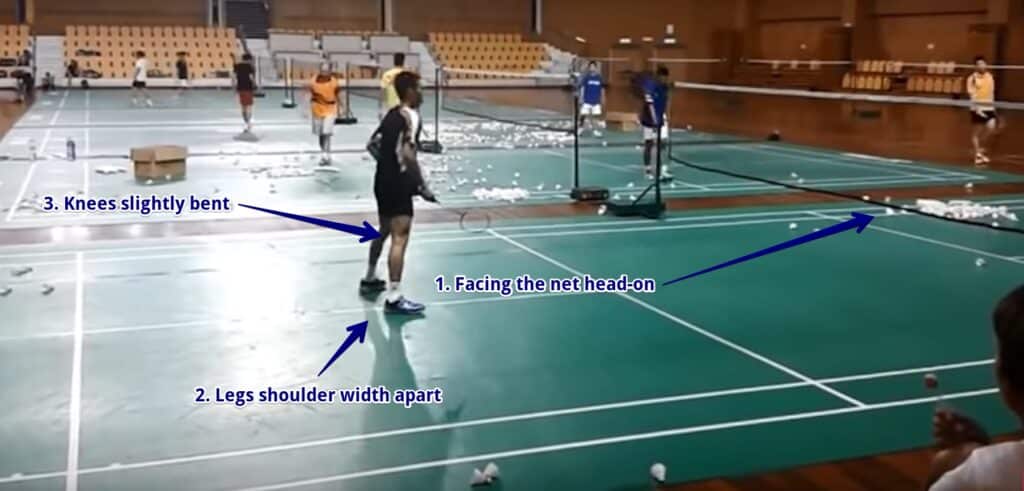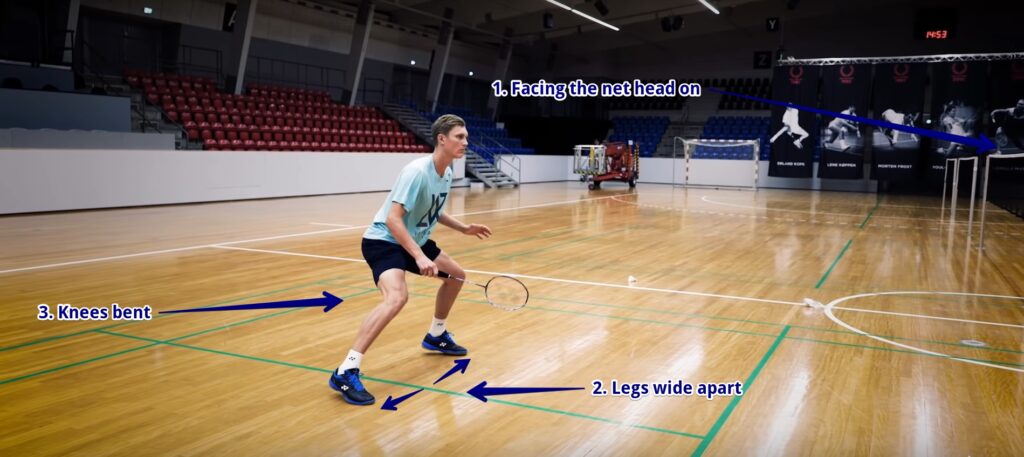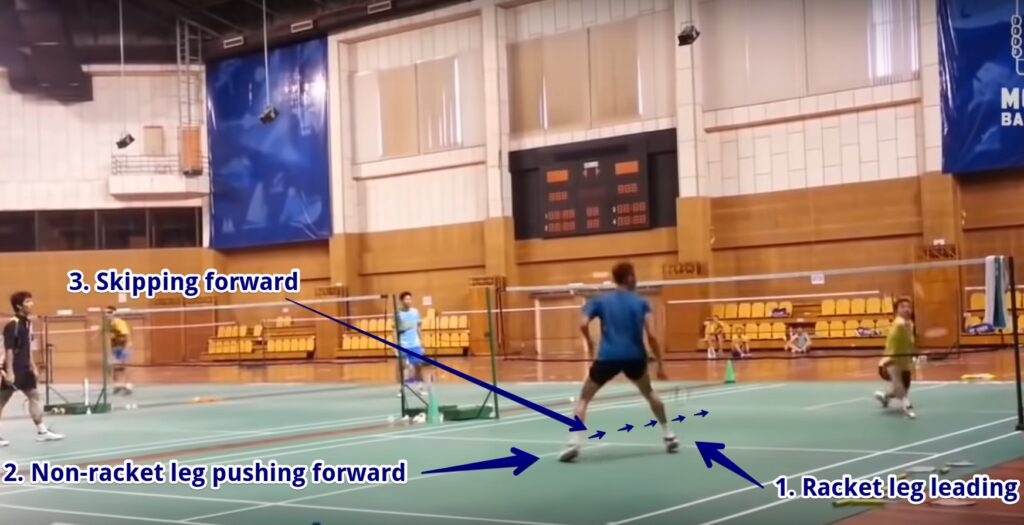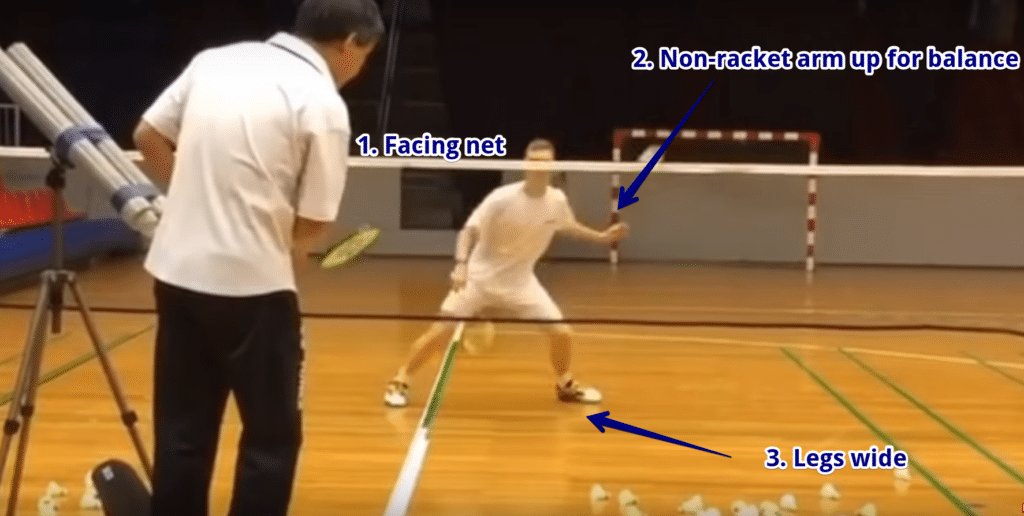Badminton is the fastest racket sport in the world, and if you’re not ready, you’ll get shuttlecocked to smithereens. Your stance in badminton is the antidote to this (and potentially a helluva lot more).
Outside of training your damndest to strike every shuttle with power and accuracy and keeping yourself flexible enough to avoid snapping an Achilles tendon – how often have you cursed away a near miss or a shot that hit the rim of the racket?
Cursing your racket, a broken feather on the shuttlecock, your opponent, and yourself when you miss a shuttle you felt you could’ve easily gotten if you hadn’t been caught off balance?
I know I have, and I’ve realized that most of the time, it’s because I was shuffling awkwardly to catch the shuttle or keep my balance (or both) before striking. I was at a disadvantage from the start because I wasn’t in a ready stance.
Your badminton stance is your launch pad for all those tasty strikes you want to hit – a.k.a. a pretty damn crucial starting point for whatever you want to do next.
When you get into the right stance, it feels like you gained an extra second or two for your next move (which in badminton time is like 40 years or something).
It’s also an essential ingredient if you don’t want to make things too easy for more experienced players who are good at keeping an eye on your position on the court.
Let’s see how something that’s likely an afterthought for most players can gain you the advantage in a rally or avoid being under constant pressure, chasing shuttlecocks at your opponent’s will.
What’s so wild about your stance in badminton?
Your stance might be a second thought, but it’s the most central part of preparing for what comes next throughout a rally.
To many players, it’s a fleeting concept because it’s how you stand right before your opponent strikes the shuttle back at you.
It’s not to be confused with footwork (how you move around on the court) or positioning (where you place yourself on the court), but it’s an important precursor for both.
The right stance makes you agile in your response and allows you to move in a specific direction in the most efficient way possible.
The wrong stance makes your following movements clumsy and strenuous, and you’ll be less likely to catch shuttles that are well-placed by your opponent.
Overall, there are four significant stances you’ll likely use throughout your entire badminton career.
- Neutral stance
- Defensive stance
- Attacking stance
- Net stance
To understand how each of these can work to your advantage, the best place to start is the neutral stance.
You can consider this a basic stance to build the optimal badminton ready position.
In a neutral stance, it’s possible to shift into both an attacking and defensive stance, in situations where it’s harder to read what strike comes at you (later, you’ll see why this is important).
In a neutral stance, your legs are side by side, shoulder width apart, and very lightly bent.

This allows you to transfer into any other stance and easily take a step in any direction on the court.
It’s likely the most useful stance since you can shift between attack and defense mode faster, and you’ll keep coming back to it as your main point of readiness when you develop enough skill to move fluidly between stances.
However, you don’t want to get caught in a neutral stance. As you can see from the image above, the neutral stance on its own doesn’t provide leverage to transfer power or movement in any direction for the next strike you want to hit.
Because of that, it should be considered a temporary phase that lets you get into other stances quickly.
But when you learn how to utilize it, it becomes the ultimate badminton ready-position.
A quick word on racket position in your badminton stances before we move on.
The common idea is that you should always keep your racket up. While this can be useful in some cases, it can also diminish power, maneuverability, and speed in your strikes and, generally, just make everything harder on yourself.
If you wonder what your racket position should be in any of the stances I cover here, the answer is; anywhere you feel comfortable and agile around the court.
It’s often awkward to move around the court with your racket up, which is why that typical advice might lock you in your stance.
If you look at professional players, they rarely play with their rackets up. Instead, they almost always keep their racket down in front of them, around their waist, or just above.
If you’ve been told to keep your racket up for readiness, this video from Badminton Insight opens up a few ideas for new ways of thinking about racket positioning.
Back to stances…
Typically, you’ll transfer into a few three types of stances from the neutral stance.
A defensive stance in badminton will frustrate opponents from the shuttles you’re able to reach
This is one of the main stances you see all the time in badminton matches, and it’s ideal for defending and catching shuttles sideways on the court.
To get into a defensive stance, you assume a similar position as the neutral stance, except your legs, are placed further apart and more generously bent.
Here’s an example from Viktor Axelsen’s training.

The big difference compared to a neutral stance is how much wider your legs are apart and that you’re in a much lower posture, ready to lunge to either side to defend against smashes along the line or other steep attacks that come at you.
It will also allow you to cover attacks in front of you where you have to step forward and catch a shuttle with a lift at the last second.
Watch how Viktor Axelsen practices this stance to defend against smashes and front-court strikes.
This stance makes him very agile – he can even reach shuttles that are played out wide on the court.
You’ll quickly notice how low he sits in this stance, and even for someone as tall as Viktor Axelsen, this allows him to lunge in the direction of the shuttle because he’s ready to expend energy and propel forward.
Having your legs wide and low also makes it easy to keep balance and regain composure for aggressive attacks that play right on the margins of the court.
When should you use a defensive stance in badminton?
As the name reveals, you want to use this stance when you’re defending in high-pressure parts of a rally.
Typically, when you’ve struck a shuttle that didn’t have enough power or accuracy and maybe sits too high in the air as an easy target for a rally-ending attack.
Getting into a low defensive stance in such situations could be the difference between returning a shuttle your opponent didn’t expect vs. scraping your racket on the floor because you weren’t able to cover the distance quickly enough.
An attacking stance in badminton can shut down your opponent’s pressure
You’re probably also familiar with the attacking stance in badminton, even if you don’t realize it.
This stance is ideal when you have more of the upper hand in a rally and expect to attack the next shuttle your opponent strikes at you.
However, there’s a distinction between two variations of the attacking stance.
Forward attacking stance
The first is forward attacking (your racket leg is leading).
Here’s an example from Lee Chong Wei’s training.

Instead of side to side, your legs are front to back. It’s also a wide stance, but not as low as the defensive stance.
The more significant difference here is that you’re not facing the net head-on, but you have your hips to the side of the court, which makes you ready to cover shuttles further ahead rather than side to side.
The forward attacking stance works by skipping forward (preserving the same posture) to lunge at the shuttle in front of you.
You can see this skipping movement here, where Lee Chong Wei lifts the shuttle back in a forward attacking stance.
Similarly to the defensive stance, notice how he keeps coming back to the starting stance after each skip forward.
When should you use a forward attacking stance?
Typically you’ll be using this stance to lift or drive shuttles back at your opponent because you’ll have an excellent power boost in your strike from your non-racket leg pushing you forward and control from your racket leg leading the strike.
Backward attacking stance
The other attacking stance is backward attacking (your non-racket leg is in front).
Here’s an example from Lee Chong Wei again.

It’s similar to a forward attacking stance, except now your racket leg is behind for control when moving backward, and your non-racket leg is in front, pushing you back. Finally, your stance is not nearly as wide or low.
It’s more relaxed, and for many players, this will feel much easier than forward attacking since you’re almost at an upright position, and it feels fluid and light to skip backward.
This clip shows Jan Ø Jørgensen practicing a backward attacking stance – notice his posture and how light he looks on his feet.
When should you use a backward attacking stance?
Exactly because this stance is more relaxed, it typically sets you up for an overhead forehand stroke, which is ideal when someone clears, lifts, or drives too high back at you because you can attack shuttles that go behind you as long as you get into this stance correctly.
Watch Lee Chong Wei use it in this clip (the first few seconds).
Notice how this allows him to follow the path of the shuttle, and strike at the right time with a devastating smash.
Now, check out his opponent (same clip).
He’s actually going into a backward attacking stance as he notices Lee Chong Wei will attack the shuttle (it’s very subtle and fast so pay close attention).
The problem is he puts his racket leg in front instead of his non-racket leg, giving him the wrong placement in his stance.
You see him skip back, but the smash is on the opposite side of his racket arm. He reaches over (awkwardly) to try and get to it, but it’s too fast and accurate for him.
Maybe with a correct backward attacking stance, he would’ve been able to skip back and strike it. Then again, the attacker is Lee Chong Wei…
Net stance in badminton for explosive net battles
The net stance is almost a hybrid between a defensive stance and a forward-attacking stance.

You’re ready to move side to side and forward.
You’re also keeping your non-racket arm stretched out for balance because this is a very tight and explosive stance.
The idea is that you can get back to the center of the court, each time, after striking a shuttle.
This way you can play the net evenly on the entire front court.
It’s also the one exception where it can be a good idea to hold your racket up for kill shots.
For example, in this training clip, Viktor Axelsen goes from his net stance and leaps into a quick kill shot that would typically end a rally.
When should you get into net stance?
The net stance is ideal for any close net battles you’ll have (duh), but it’s probably also the most intense stance because everything depends on you being highly explosive and ready for rapid movement.
Here you get a good idea of the optimal use of the net stance.
Switching between different badminton stances: an elegant and devastating technique
Although you might use some of these stances more than others, none of them can individually conquer a badminton court.
The key to getting the most out of your stances is to switch between them.
Remember the neutral stance at the beginning? You’ll see its full use now.
The neutral stance works as a great starting point because you can transfer into any stance – quickly.
The question is, how do you know when to switch between stances?
Stance depending on your stoke towards the opponent
It’s not the most effective way, but definitely, the easiest way to get into a ready stance before your opponent hits the shuttle back, and with a few educated guesses, you’ll probably get it right (most of the time).
Let’s assume you always start in a neutral stance.
If you…
- Clear – be ready to switch into a forward-attacking stance
There’s a good chance your opponent will either drop or smash the shuttle back, and since you clear from the backcourt most of the time, you’ll likely have more opportunities by being ready to move forward. If they clear, you should still have time to change your stance.
- Lift – be ready to switch into a defensive stance
Lifts open up for smashing opportunities, so you want to be ready to pick up a steep smash on either side of the court. Again if it’s a clear instead, you’ll have time to switch into a backward attacking stance and potentially attack the shuttle.
- Drive – Keep a neutral stance but be ready for a defensive stance
Drive shots are a little tricky since you often hit them straight at an opponent, forcing them to drive back or go for a net shot.
- Drop – be ready to switch into a forward attacking stance or a defensive stance
Drop shots often get returned with close net shots or lifts, so you’d want to be ready to lunge towards one of those. If you’re not that far back on the court, shuttles to the front court can be countered from a defensive stance.
- Smash – switch into a forward attacking stance
Most of the time your opponent will return your smash with a stroke that lands the shuttle just above the net or somewhere on the front court. Being ready to attack forward would allow you to send a kill shot next or lift far back.
- Get into a net battle – switch into a net stance followed by a backward attacking stance
A net stance is an obvious choice when you’re getting into net battles, but at some point, your opponent (or you) will likely send the shuttle to the rear court, so you want to be ready to assume a backward attacking stance when that seems likely to happen.
As you can see from the examples above, these are merely educated guesses, so don’t take them too literally.
Sometimes the attack and defense coming back at you will be completely different from what you can guess depending on your own strokes.
That brings us to the next part…
Choosing your badminton stance by observing your opponent
Getting good at predicting your opponent’s next move comes down to watching and reading what they do before they hit the shuttle back at you.
It takes a lot of time both playing and watching matches to get good at this, and of course, it’s different from player to player. But a good starting point is to take outset in the badminton stances we just went through, which give away specific indicators for what a player is about to do.
You’ll need to do your best at observing your opponent the second after you strike the shuttlecock back at them and make a quick estimate about what they’re doing.
Are they facing the net head-on or standing sideways? Are they getting low and wide, ready to defend? Are they skipping backward? Are they leading with their racket leg?…
Make a quick observation about your opponent’s stance, and predict the outcome of their strike.
You can’t get this right every time – just go with your best estimate.
For example, if you hit a drop, that could mean preparing a defensive or forward-attacking stance. Then you notice your opponent leads with their racket leg. Now, you can expect they’ll lunge into the shuttle with a net shot, so you get into a forward attacking stance, ready to cover the net.
Here’s a quick sum-up of the main indicators to look for in your opponent’s stance:
- Defensive stance = wide and low
- Forward attacking stance = leading with racket leg
- Backward attacking stance = racket leg behind
- Net stance = Similar to defensive (non-racket arm up)
If you’re able to make these observations, you’ll be at a massive advantage to predict your opponent’s next move.
Anticipating the next shuttle in a super fast rally can mean the difference between directing the shuttlecock where you want it to go vs. defending for dear life and setting your opponent up for a kill shot.
The pros are insanely good at this.
Check this video clip where Kento Momota anticipates Viktor Axelsen’s smash (one of the most notorious smashes in the sport) and makes it look like it’s no threat.
The constant fluid cycle of badminton stances
Ideally, you’ll want to merge these two approaches when switching in and out of stances, but as we all know, badminton is a fast game, and you have to make most of these decisions in split seconds.
As you develop more as a player, stances in badminton should eventually become more of an effortless and automatic thing in the back of your mind rather than conscious decision-making.
You’ll have way too much to think about to carefully select a stance when you concentrate on strikes and watching for openings in your opponent’s game.
When you get very advanced in your badminton stances, you’ll switch between them in constant fluid and effortless motions.
Here’s an example where Lee Chong Wei switches from forward attacking – to backward attacking – to defensive – to a forward attacking stance. Keep in mind this is an insanely high level.
Takeaways
To work on your stances, you should start doing two things.
1. Analyze badminton matches and notice how the pros switch in and out of these constantly and when they do it. 2. Start practicing individual stances during drop-ins or on club nights and then incorporate them in training matches.
You can go about practice this way:
- Use the essential stances from this article and practice them individually
- Start by going into a stance, based on the type of strike you hit the shuttle with
- Use your best estimate of your opponent’s stance, to guess how they’ll strike back at you
- Practice switching in and out of different stances before your opponent hits the shuttle, and make it a rule to start in one of these stances before moving around the court
It’s a lot of trial and error, but eventually, you’ll develop a lot of muscle memory and experience this working on autopilot.